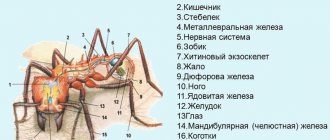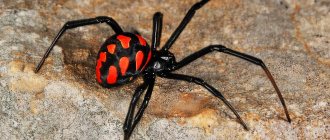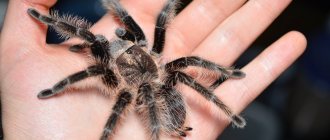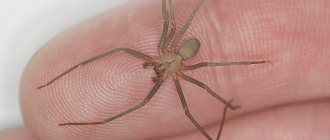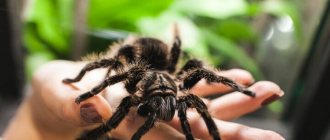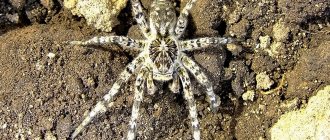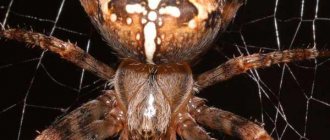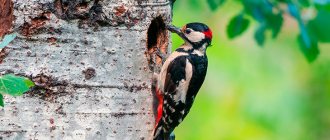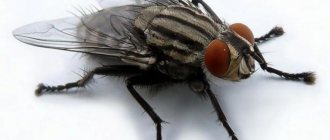Not everyone knows how many legs a spider has, because it seems like there are a lot of them because of fear, the answer is always clear - 8. There are many species of “arachnids” on our planet. In addition, some species are very poisonous, and many of them are completely safe.
It should be noted that there are species that live in human homes as pets. Why not, especially since they eat little and leave virtually no waste.
How many legs does a spider have?
If we take all the species present on our planet, there are more than 40 thousand of them. They all differ in size, life characteristics, appearance, color, etc. As far as we know, the spider has 4 pairs of legs, which are located on the cephalothorax, 4 on each side. All legs are associated with the process of moving the spider and do not perform other functions.
The legs consist of:
- From the pelvic segments.
- From the trotters.
- From the hip.
- From the knee.
- From the shins.
- From the heel segments.
- From the paws.
The spider's legs are armed with claws, spines, or have the appearance of claws. The front pair is the longest, the second pair is the shortest, and the third pair can be described as medium in length.
The back pair is almost the same size as the front pair. Spiders have all their legs, the average size is about 2 cm, although there are spiders with legs about 15 cm long or even with legs up to 35 centimeters long.
Interesting to know! It is believed that the Goliath spider and the hunter have a maximum leg length of 15 centimeters. The giant baboon spider and the Brazilian wandering spider have a leg length of about 9 cm. The leg length in tegenoria is 7 cm, and in the nephilist spider it is 5 cm.
Execution cannot be pardoned
There are several signs that tell what the killing of a spider promises, and there are even some that contradict each other. But today we will move away from popular beliefs and look at several theories that, as it seems to us, are ways to explain why you should not kill spiders.
- According to legend, once upon a time a spider's web saved a man's life. He was persecuted and, forced to flee, hid in a cave, which was almost completely entangled in spider webs. The pursuers were never able to find the fugitive; they didn’t even bother to examine the cave - there were so many cobwebs in it.
- The second version, which tells why you should not kill spiders in the house, is based on their active use in folk medicine of past times. In ancient times, healers mainly used various decoctions and infusions to heal the sick, to which they added not only herbs, but also insects. Often the role of a healing “ingredient” was a spider, ideally poisonous. They treated with poison, so killing a spider without any serious purpose promised the rapid development of the disease.
- The third legend says that spiders attract happiness - it gets entangled in their web and remains in the house. And the owner of the fishing nets, who has settled in a residential building, is a symbol of good news and prosperity. For this reason, killing a spider means driving away happiness from the house - there will be no one to spin the web and all the good things from the house will soon “fly away” along with the last silk threads.
Small house spiders are not capable of causing harm to human health
And if there are several of them, then this is a reason to pay attention to the cleanliness of your own home. In this situation, it is not the spiders that should be destroyed, but the reason why they ended up in the apartment
Remember, spiders will always live where there is food for them.
For many people, spiders cause fear and some kind of hostility. I treat them with indifference. I won’t say that I’m afraid of them, but I don’t feel love for them either. Outside my window there is a tree with lush foliage; in the summer, one small spider settled there. One day I was watching him and noticed some peculiarities. I think you will also be interested in learning about them.
Functions of spider legs
In all types of spiders, the legs perform the same functions, and the most important of them is walking, which allows the animal to move in space, and sometimes quite quickly.
The main difference between the legs of spiders is their length and structure, which determines the way they move and their speed. Thus, spiders can crawl, move quickly, walk sideways and jump considerable distances (relatively speaking).
On each paw you can see villi, with the help of which the spider reacts, or rather interacts with the external environment. With the help of their limbs, spiders move through space, capturing sounds and smells. Once in an unfamiliar place, the spider moves its paws for a long time, studying the situation. Only then does he decide to take the “first step”.
A pair of forelimbs perform a variety of operations. With the help of its front legs, the spider obtains food; if necessary, it can dig a hole, weave a web, form a cocoon, place the cubs on its back, and so on.
Why can't a spider get tangled in its web?
The spider trap system is almost perfect.
Their web consists of thin, but at the same time durable silk threads. They are assembled into a single fabric-type structure, consisting of complex geometric shapes and quite effective. The insect's web is treated with a special sticky organic glue that permanently immobilizes the prey. The spider itself moves along its web very quickly and its legs do not stick to it.
The thing is that only the circular threads are covered with biological glue, into which the victim gets caught. But the one who created the web moves only along threads not covered with glue.
In addition, biologists have found that the hairs located on the heel joints of insects are covered with a special substance that prevents them from sticking to the adhesive layer of the web. Scientists treated the spider's paws with a soap solution, and then alcohol, and placed the spider's web woven on it. To the surprise of biologists, the spider got stuck there because it had lost the protective layer on its legs.
Chelicerae and pedipalps
Some species of spiders have long chelicerae that are slightly smaller than their forelimbs. They are located in front of the cephalothorax and are often confused with legs, since the spider has 10 of them.
The same is true for the pedipalps, whose function is to grind food. The pedipalps are mobile tentacles, while the colicerae are more like claws or claws.
Below in the photo you can see spiders in which both the chelicerae and pedipalps are quite developed.
Neighborhood with a person
House spider
Some species of spiders live near humans. They settle in places where there is enough food. They mainly feed on insects, but their diet depends on the type of arthropod.
The following spiders can be found at home:
- Brownie . This is a small spider measuring from 6 to 12 mm, yellow in color. The body is decorated with a brown pattern. Females are always larger than males. They weave a funnel-shaped web.
- Tramp . Hobo spiders enter a person’s home by accident. They do not weave webs; they catch their prey on the move. As soon as all the insects are destroyed, the tramp leaves the house and moves on.
- Haymaker . Depending on the species, the size of the arthropod can be 2-10 mm. Moreover, its limbs are 5 times the size of its own body. It likes to weave webs on windows, for which it received its second name - window spider. To catch prey, the spider needs to position itself upside down near the placed net. When an insect becomes entangled in a web, the spider rushes towards it, bites it, then injects poison.
Why spiders appear in the house, the answer to this question is simple - dampness, high humidity, unsanitary conditions or an abundance of insects that multiply in large quantities and move from room to room.
These insects include beetles, fruit flies, mosquitoes and various spiders.
Why does a spider have 8 legs?
According to experts, the spider would have enough 3 pairs of legs to perform all vital functions. Most likely, the couple is like an escort, since spiders often find themselves in difficult situations.
As a result, the couple may break up or be injured. In natural conditions, there are many individuals that, for one reason or another, lack one or two pairs of legs, which also often leads scientists to a dead end.
Interesting moment! If a spider for some reason has lost a leg, a new one will not grow in its place, although with 3 pairs of legs the arachnid continues to exist normally, performing its basic functions.
About arachnophobia
Science knows more than 40 thousand species of spiders. Some stand out for their size, others for their toxicity, and others for their color. But at the same time, for the majority, the appearance of absolutely all arachnids is unattractive, and some experience panic fear of them. Such people are called arachnophobes.
But why are people afraid of spiders? After all, if you look at it, the arachnid has much more reasons to fear a person - he has much less chance of causing us any harm than we have in relation to him. Thus, the phobia itself seems somewhat irrational.
There is a theory that the fear of spiders dates back 350 million years ago, to a time when humans did not yet exist. Fossil arachnids were mostly poisonous and posed a serious threat to primates. As a result, the latter developed a reflex of situational readiness - when a spider appeared, they were forced to hide with lightning speed. Over time, the number of deadly species became much smaller, but the instinctive fear remained. Thus, it turns out that arachophobia developed as part of human evolution.
Difference from insects
The spider belongs to the class of arachnids, it is not an insect . Characteristic features of this type:
- The main difference between arachnids and insects is that the last 6 legs are located on the chest, and not on the cephalothorax. In addition to external differences, animals have different structures of internal organs.
- Centipedes are also not insects, since they belong to a separate species.
- If we compare the body structure of arachnids with other creatures, it can be more closely related to a scorpion.
Spiders that live in apartments cannot harm the human body. You need to pay attention to sanitation conditions. Animals live in houses where there is enough food to remove them, it is necessary to get rid of the main cause of the invasion.
Classification
There is no uniform classification system for spiders. One can only correlate their specific types by density of distribution, rarity of a particular species, safety or threat to human life, and size.
Safe spiders
This species includes representatives of the animal world that do not harm people. They are either unable to bite through the skin at all, or their venom does not pose any threat.
These arachnids include:
- crosses,
- tarantulas,
- haymakers (mowers),
- horses,
- brownies.
Cross spider
Deadly poisonous
In most cases, spiders do not pose any threat to humans. Especially if you don't try to deliberately anger him. But there are also those with whom it is better not to meet.
Arachnids that are truly poisonous and dangerous:
- karakurt,
- black Widow,
- Brazilian Runner Spider,
- banana Spider,
- brown recluse.
Brown recluse spider
Rare
Some spiders can be found everywhere, while others are very rarely seen.
Such distinctive arthropods include:
- nephila-goldweaver,
- baboon spider,
- sydney spider Funnel Web,
- Colombian purple tarantula,
- phalanx spider,
- giant crab.
Golden spider
Little ones
Like all representatives of the animal world, spiders tend to vary in size. And if large arthropods evoke fear and disgust, then baby spiders can even evoke tenderness.
These babies include:
- anapistula,
- patu digua,
- side walker,
- Kipling's Bagheera
- Abacarus histrix.
Sidewalk spider
Large
And next to these little ones live real giants who are impossible not to notice.
Particularly large species:
- tarantula Theraphosa Blonda,
- orb-weaver-nephila,
- tarantula,
- giant crab,
- banana spider.
Tarantula
More about butterflies
This insect belongs to the species of arthropods; it is the most developed among invertebrates. There is hardly a person who would look indifferently at such a beautiful insect. She has a complex “life path”; she goes through a metamorphosis from a crawling caterpillar to a butterfly.
Back in the nineteenth century
Scientists classified butterflies as various insects, but soon experts put everything in its place. Currently, more than 110,000 types of butterflies have not been studied.
Using hives as an example, this article will look at how many legs a butterfly has, and how they transform from a caterpillar.
Urticaria is most often found in the area
Russian Federation, she is a representative of the nymphalid family.
Where can you find hives:
- North America;
- Asia;
- Europe;
- Japan;
- China.
Urticaria gets its name from its love of food in the form of nettles. In the fall, the male wren dies, and the females remain to spend the winter in various sheds, basements, crevices and other hidden areas. In winter, urticaria wraps its wings around its body like a blanket. Sometimes it freezes completely, becoming like a piece of ice.
Urticaria belongs to a small species of light-winged beauties
, which overwinter as adults. The butterfly comes out of hibernation early, this happens in April.
Amazing facts
The world of spiders is very diverse. These are unique and charming animals:
- There is a separate subspecies of the spider family called phrynes. It includes approximately 60 individuals. They have certain characteristics, the main one being that they do not know how to weave a web. They have quite large legs, and the front jaws, intended for hunting, are very strong.
- Spiders have no skeleton, only a hard shell. Because of this structure, the size of all arachnids is small. There are no large specimens that are shown in movies. Otherwise, the animal would have died under its own weight.
- It has been proven that the web is stronger than steel and other metals that exist in the world. Scientists still cannot make it artificially.
- The number of eyes in spiders can range from 2 to 12, and not 8, as many people think.
- During the hunt, arthropods react to vibrations. They can be recreated using a violin. To lure the spider out of its hiding place, you just need to play the instrument.
- The population of Cambodia keeps the tarantula spider as a pet, consuming the arthropod as food, as it is a magnificent delicacy.
- All varieties of spiders make a web in the shape of a circle, and only the gladiator makes a square, and the web of the orb weaver can reach up to 8 m in size.
Most people are terrified of spiders. This fear is called arachnophobia. However, in reality, these small representatives of arthropods have much more reasons to be afraid of humans. Spiders are the most unusual animals living on Earth. They received such fame due to the features that nature gave them.
Sources
- https://felisov.ru/zhuki/skolko-nog-u-pauka.html
- https://kursi-floristiki.ru/pauki/skolko-lapok-u-pauka.html
- https://100zaitsev.ru/chlenistonogie/kolichestvo-nog-u-paukoobraznyh.html
- https://MyTigers.ru/nauka/u-pauka-nogi-ili-lapy.html
- https://tapi-tapi.ru/paukov-lapy-nogi/
- https://WikiParazit.ru/pauki/lapy-pauka-kolichestvo-i-funktsii.html
- https://zoomservice.ru/pauki/skolko-lapok-u-pauka-otvet.html
- https://agrovetspb.ru/nasekomye/skol-ko-lap-u-pauka-ih-dlina-i-funkciya.html
- https://klopkill.ru/nasekomye/pauki/85-skolko-nog-u-paukov-i-zachem-oni-im-nuzhny.html
- https://parazitdoma.ru/drugie-parazity/skolko-nog-u-pauka
- https://nauka.club/biologiya/nogi-paukoobraznykh.html
- https://prusakam.net/skolko-nog-u-pauka/
- https://zverila.ru/pauki/vnimanie-pauk-skolko-nog-u-nasekomogo-i-zachem-oni-nuzhny.html
- https://TaraKlop.ru/pauki/skolko-nog-u-pauka/
[collapse]
